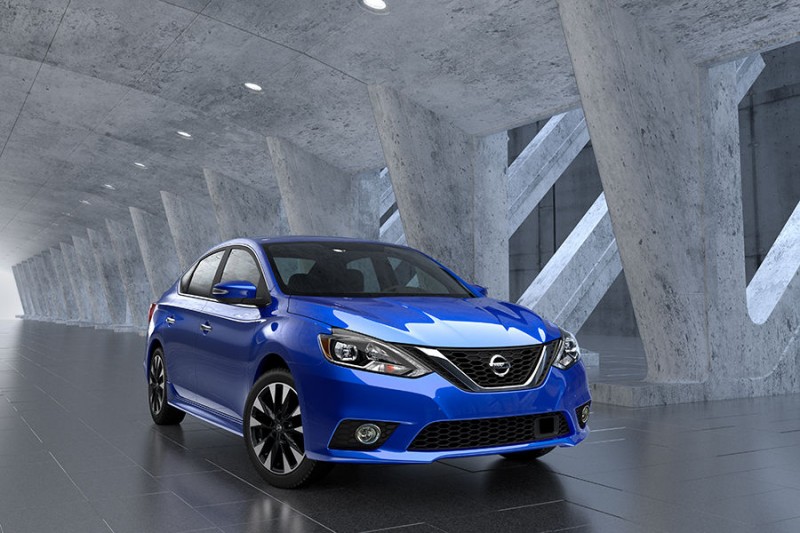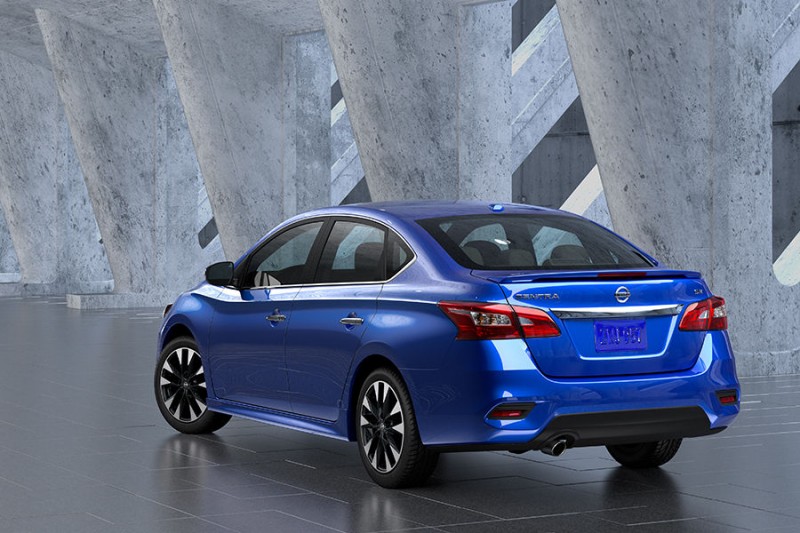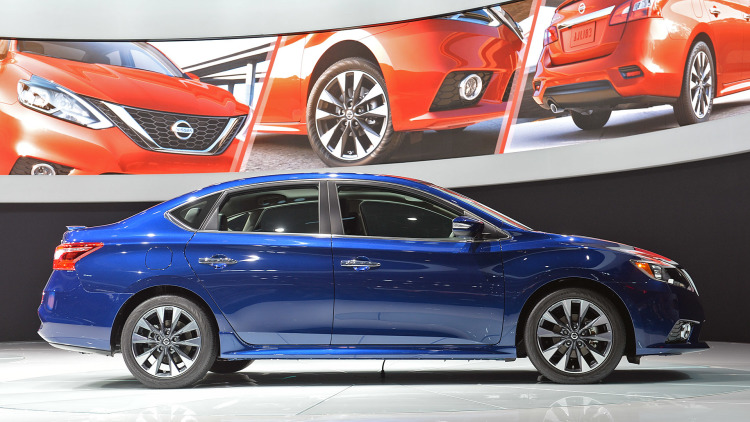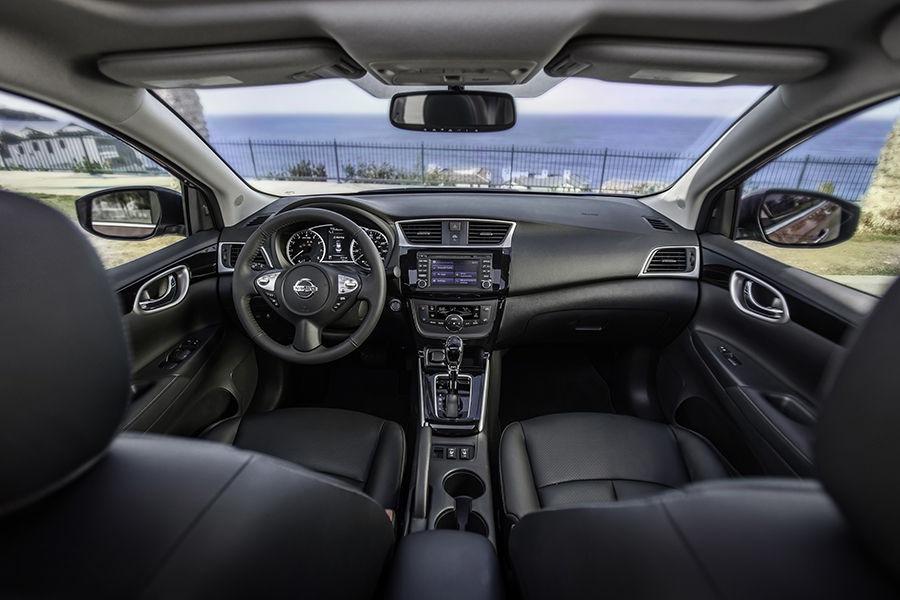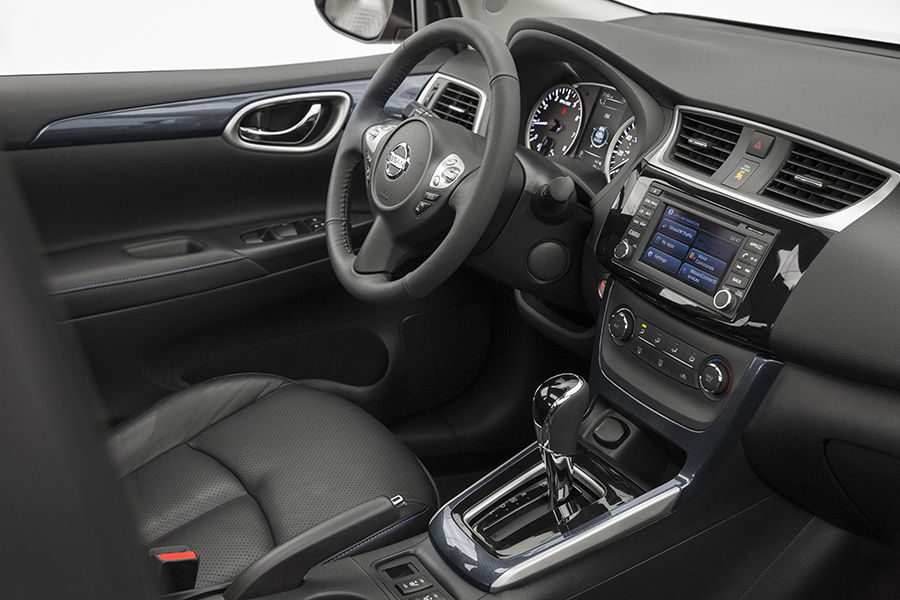What’s New for 2016
Revised front and rear styling aligns the 2016 Sentra with the current Altima and Maxima sedans. Inside, there’s a new steering wheel and some revised dashboard elements, while a high-resolution driver information screen is added to the SV, SR and SL trims. Newly available features include a power driver seat, adaptive cruise control and a few safety technologies (automatic emergency braking, a blind-spot monitor with rear cross-traffic alert and NissanConnect emergency telematics).
Introduction
The 2016 Nissan Sentra doesn’t necessarily stand out in the compact sedan segment, but that doesn’t mean it’s a penalty box. Perhaps most notably, the Sentra’s backseat delivers space and comfort that rival some midsize sedans, and the trunk is just as generous. On the road, the Sentra certainly isn’t thrilling, but its powertrain is fuel-efficient and generally unobtrusive. We gave the Sentra a respectable rating before its 2016 refresh, and all of the improvements this year aren’t likely to hurt our impression of this little sedan.
Indeed, that refresh turns out to be pretty thorough. The exterior styling has been overhauled and is now appreciably more upscale, while the revised interior trim and new technology and safety features give shoppers further food for thought. Alas, the relatively underpowered 130-horsepower four-cylinder engine soldiers on unchanged, though Nissan says the continuously variable transmission (CVT) has been retuned for better responsiveness, as has the car’s suspension. Overall, the various nips and tucks don’t transform the Sentra into a segment leader, but they certainly sweeten the pot, especially given the enduringly strong EPA fuel economy ratings of 30-34 mpg combined.
Depending on your needs, the Sentra might be a terrific choice in the segment. If you’re looking for something with a more involving driving experience, both the Ford Focus and Mazda 3 offer trims that will meet those needs. A particularly strong contender is the Honda Civic, which is all-new and vastly better this year. If you’re in the segment for value, then the 2016 Hyundai Elantra might be your huckleberry. But no matter which way you slice it, the 2016 Nissan Sentra is no slouch.
Body Styles, Trim Levels, and Options
The 2016 Nissan Sentra is a compact five-passenger sedan offered in S, FE+ S, SV, SR and SL trim levels.
The base Sentra S comes with 16-inch steel wheels, automatic headlights, remote keyless entry, air-conditioning, a height-adjustable driver seat, a sliding front armrest, 60/40-split folding rear seatbacks, a tilt-and-telescoping steering column, cruise control, full power accessories and a four-speaker sound system with a CD player, a USB port, an auxiliary audio jack and Bluetooth phone connectivity.
The FE+ S version largely shares the S trim’s equipment, but it prioritizes fuel economy with low-rolling-resistance tires, a rear spoiler and underbody aerodynamic deflectors.
A step up is the SV, which adds keyless entry and ignition, upgraded cloth upholstery, a leather-wrapped steering wheel, a 5-inch driver information screen, a 5-inch central touchscreen, a rearview camera, Nissan connect integrated smartphone applications (including hands-free text messaging capability), Siri Eyes Free voice controls for Apple devices, satellite radio, Bluetooth audio connectivity and a six-speaker sound system.
The sporty SR gains 17-inch alloy wheels, rear disc brakes, a sport body kit, foglights, heated mirrors with integrated turn signals, sport cloth upholstery and heated front seats.
The top-grade SL loses the SR’s sport-themed flourishes but gets 17-inch alloy wheels of its own plus the rear disc brakes, a six-way power driver seat (with power lumbar), leather upholstery, a larger 5.8-inch touchscreen with navigation, dual-zone automatic climate control and an auto-dimming rearview mirror. A blind-spot monitor with rear cross-traffic alert is also standard on the SL.
The All Weather package (SV only) includes heated front seats and heated outside mirrors. The Style package (SV only) adds a sunroof, unique 16-inch alloy wheels, illuminated vanity mirrors and LED interior lighting. Optional for the SR and SL is the Premium package, which adds the Style package’s contents (minus the 16-inch wheels) plus an eight-speaker Bose audio system and (for the SR only) the upgraded 5.8-inch touchscreen with navigation, the blind-spot monitor with rear cross-traffic alert, leather upholstery and the auto-dimming rearview mirror.
The Technology package (available on SR and SL models) includes adaptive cruise control, a forward collision mitigation system with automatic emergency braking and NissanConnect emergency telematics.
Powertrains and Performance
Every 2016 Nissan Sentra gets a 1.8-liter four-cylinder engine rated at 130 hp and 128 pound-feet of torque. A six-speed manual transmission is standard on the S and FE+ S trims, while a CVT is optional on those models and standard on all other Sentras.
In Edmunds testing, a Sentra SL accelerated from zero to 60 mph in 10.1 seconds, which is among the slowest times for this class of car.
The EPA estimates that the six-speed manual Sentra will achieve 30 mpg combined (27 city/36 highway). Opting for the CVT ups fuel economy to 32 mpg combined (29 city/38 highway). The FE+ S model achieves an impressive 34 mpg combined (30 city/40 highway).
Safety
The 2016 Nissan Sentra comes standard with antilock brakes, stability control, tire-pressure monitoring, front-seat side airbags, full-length side curtain airbags and active front head restraints. A rearview camera and Nissan’s Easy Fill Tire Alert System (which uses audible and visual signals to help you achieve the correct pressure when adding air) are standard starting at the SV trim level. The SL comes standard with a blind-spot monitor with rear cross-traffic alert, while available features include a forward collision mitigation system with automatic braking: an unusual perk in this class.
More basic Sentra models come with rear drum brakes, but rear disc brakes are standard on the SR and SL. However, in Edmunds brake testing, a Sentra with the less costly rear drum brakes stopped from 60 mph in 118 feet, a better-than-average distance for the segment. A Sentra SL stopped in 113 feet, which is almost unheard of for a compact economy sedan.
In government crash tests, the 2016 Sentra earned an overall rating of four star (out of a possible five), with four stars for frontal impact protection and five stars for side-impact protection. The Insurance Institute for Highway Safety awarded the 2016 Sentra its best rating ofGood in its moderate-overlap and small-overlap frontal-offset impact tests. The Sentra also earned a “Good” rating in the side-impact, roof-strength and seat and head restraint (whiplash protection) tests.
Interior Design and Special Features
Although the Sentra’s conservative overall interior design isn’t going to wow you, the cabin gives the impression of being well-made overall. Standout features include smartphone-app integration via NissanConnect, which allows you to do Google searches via the car’s 5.8-inch touchscreen interface in navigation-equipped models. SV and higher trims offer Siri Eyes Free voice recognition, which allows iPhone users to utilize any Siri function via a button on the steering wheel. In Sentras without navigation, you can still stream Internet radio (Pandora or iHeartRadio) and monitor text messages and social media.
Luggage capacity is generous for the class. At 15.1 cubic feet, the Sentra’s trunk volume is comparable to that of some midsize sedans.
Driving Impressions
The 2016 Nissan Sentra’s 130-hp engine is pleasantly muted while accelerating moderately and cruising at freeway speeds. The CVT is one of the better offerings on the market, as there’s little of the stomach-churning “rubber-band” effect during acceleration that’s common to many transmissions of this type. Partly, that’s down to Nissan’s simulated stepped-shifting, which approximates the feel of a traditional automatic transmission with discrete gears. Just don’t be in a hurry, because with so little power under the hood, the Sentra never is.
It finds an agreeable middle ground in the ride quality department, however. For the most part, this Nissan’s ride is fairly smooth and sophisticated. Handling around turns is respectable, and the Sentra has responsive, reassuring steering. The brakes are also more than adequate and provide plenty of stopping power, along with an intuitive pedal feel.
Source: Edmunds

